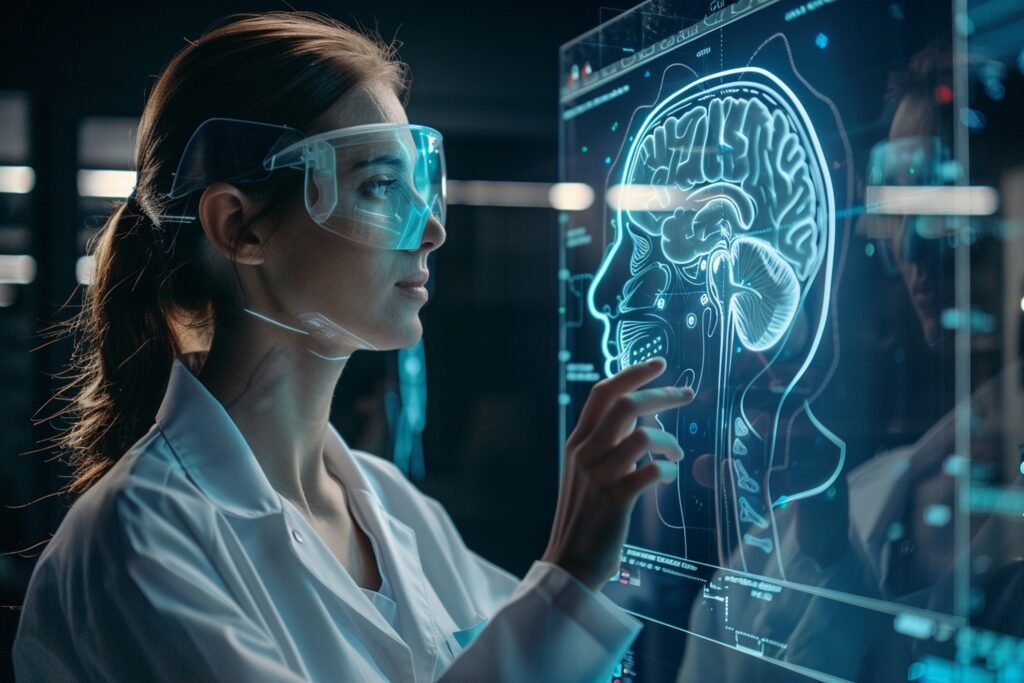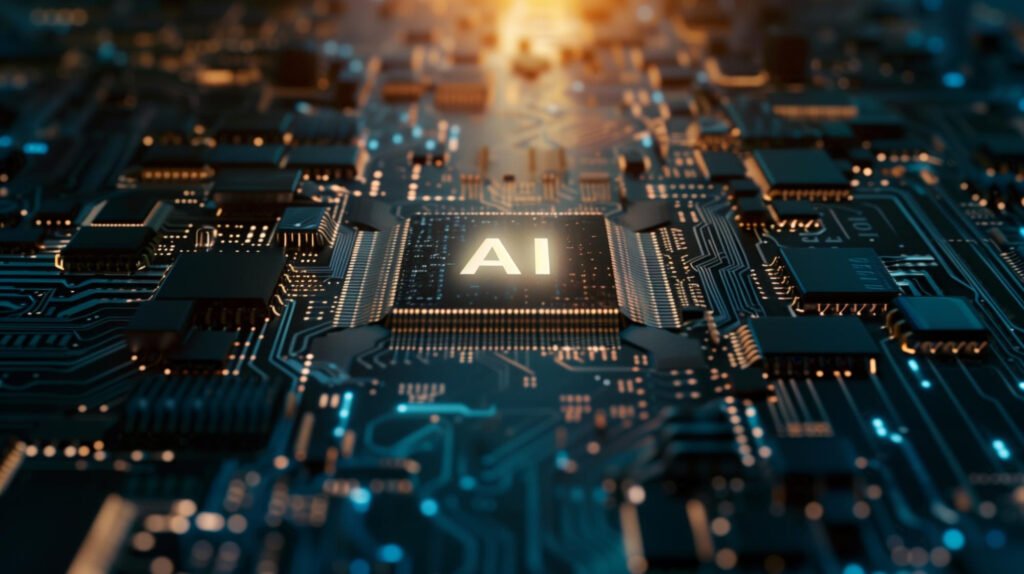How AI is Transforming Healthcare

In recent years, artificial intelligence (AI) has emerged as a game-changer in various industries, and healthcare is no exception. With its potential to revolutionize patient care, streamline operations, and enhance research, AI is at the forefront of a technological transformation in healthcare. This blog post will explore the key ways AI is reshaping the healthcare landscape and its profound impact on patients and providers. 1. Early Diagnosis and Disease Detection One of AI’s most significant contributions to healthcare is its ability to diagnose diseases at an early stage. AI algorithms can identify patterns that human doctors might miss by analyzing vast amounts of medical data, including imaging, lab results, and patient histories. For instance, AI-powered tools can detect early signs of cancer, such as breast or lung cancer, with remarkable accuracy, enabling timely intervention and improving survival rates. 2. Personalized Treatment Plans AI enables the creation of personalized treatment plans tailored to individual patients. By considering a patient’s genetic makeup, lifestyle, and medical history, AI can recommend the most effective treatments and predict how patients will respond to specific therapies. This personalized approach enhances treatment outcomes and minimizes adverse effects, leading to better patient experiences. 3. Predictive Analytics for Patient Management Predictive analytics powered by AI is revolutionizing patient management. Hospitals can now predict patient admission rates, optimize bed occupancy, and allocate resources more efficiently. AI can analyze patient data for chronic disease management to predict flare-ups or complications, allowing for proactive interventions and reducing hospital readmissions. 4. Enhanced Medical Imaging AI is transforming medical imaging by improving the accuracy and efficiency of image analysis. Radiologists can leverage AI algorithms to detect abnormalities in X-rays, MRIs, and CT scans more precisely. This speeds up the diagnostic process and reduces the likelihood of human error. In some cases, AI systems have demonstrated the ability to identify previously undetectable conditions. 5. Virtual Health Assistants Virtual health assistants powered by AI are becoming increasingly common. These assistants can provide patients with round-the-clock support, answer health-related queries, schedule appointments, and even offer medical advice based on symptoms. This level of accessibility and convenience enhances patient engagement and helps reduce the burden on healthcare providers. 6. Drug Discovery and Development AI is accelerating drug discovery and development, which has traditionally been time-consuming and costly. AI can identify potential drug candidates and optimize clinical trial designs by analyzing biological data and predicting molecular interactions. This reduces the time required to bring new drugs to market, ultimately benefiting patients who need innovative treatments. 7. Improving Clinical Decision-Making AI is a powerful tool for enhancing clinical decision-making. By integrating data from electronic health records (EHRs), medical literature, and clinical guidelines, AI systems can provide evidence-based recommendations to healthcare providers. This support helps clinicians make informed decisions, leading to better patient outcomes and more efficient care delivery. 8. Administrative Efficiency Beyond direct patient care, AI is streamlining administrative tasks in healthcare. From automating billing and coding to managing patient records and scheduling, AI reduces administrative burdens and frees up valuable time for healthcare professionals to focus on patient care. This efficiency can lead to cost savings and improved overall productivity in healthcare organizations. 9. Telemedicine and Remote Monitoring AI plays a crucial role in the growth of telemedicine and remote patient monitoring. AI-powered platforms can analyze data from wearable devices and remote monitoring tools to track patients’ health in real-time. This allows for continuous monitoring of chronic conditions, early detection of health issues, and timely interventions, all from the comfort of a patient’s home. Conclusion Integrating AI in healthcare is a technological advancement and a paradigm shift that promises to improve patient outcomes, enhance operational efficiency, and drive innovation. As AI continues to evolve, its potential to transform healthcare will only grow, paving the way for a future where medical care is more personalized, accurate, and accessible. Embracing AI in healthcare is not just an option; it is necessary to build a healthier and more sustainable world.
Predicting AI Advancements by 2050: What to Expect

As we look toward the future, the potential advancements in artificial intelligence (AI) by 2050 promise to revolutionize our world in unprecedented ways. Here’s a glimpse into what we might expect: 1. Exponential Growth in AI Capabilities AI has been progressing at an astonishing rate. By 2050, we can anticipate AI systems surpassing human intelligence in many domains. These systems will perform complex computations and exhibit advanced problem-solving abilities, creativity, and emotional intelligence. 2. AI in Everyday Life AI will become deeply integrated into our daily lives. From personalized virtual assistants that understand and anticipate our needs to smart homes that manage themselves, AI will streamline and enhance our daily routines. Imagine refrigerators that automatically order groceries or cars that drive us safely and efficiently. 3. Transformations in Healthcare The healthcare sector will likely see significant advancements due to AI. Predictive analytics could foresee health issues before they arise, enabling preventative care. AI-driven diagnostics and personalized medicine will improve treatment accuracy and efficacy, potentially increasing life expectancy and quality of life. 4. Educational Evolution AI will revolutionize education by providing personalized learning experiences. Adaptive learning platforms will tailor educational content to individual student’s needs, helping them learn at their own pace and style. This will make education more accessible and effective worldwide. 5. AI and the Workforce The job market will undergo substantial changes. While some jobs may become obsolete, new roles requiring advanced AI skills will emerge. Humans and AI will collaborate closely, with AI handling repetitive tasks and humans focusing on creative and strategic work. This shift will necessitate transforming education and training systems to prepare the workforce for future demands. 6. Ethical and Regulatory Challenges With great power comes great responsibility. The ethical implications of advanced AI will be a significant concern. Ensuring AI is used for the benefit of humanity, avoiding biases, and protecting privacy will be critical. Governments and organizations must develop robust frameworks to regulate AI development and deployment. 7. Artificial General Intelligence (AGI) One of the most anticipated milestones is the development of Artificial General Intelligence (AGI) – AI that can understand, learn, and apply knowledge across various tasks, much like a human. Achieving AGI will open up new possibilities and challenges, including ethical considerations and control mechanisms. 8. Global Collaboration The future of AI will likely involve global collaboration. Countries and organizations worldwide must work together to share knowledge, establish standards, and address the global challenges posed by advanced AI. 9. AI in Creative Fields AI will also make significant strides in creative fields such as art, music, and literature. AI-generated content will push the boundaries of creativity, leading to new forms of artistic expression and collaboration between humans and machines. 10. Enhanced Human Capabilities Finally, AI could enhance human capabilities through brain-computer interfaces and other technologies. These advancements may enable humans to augment their cognitive and physical abilities, leading to a new era of human evolution. Conclusion The potential advancements in AI by 2050 are both exciting and challenging. As we move forward, it’s crucial to guide the development of AI in a way that maximizes its benefits while addressing ethical and societal concerns. The future with AI holds immense promise, and with careful consideration and collaboration, we can ensure it leads to a better world for all.
Top 10 Best Data Integration Tools of 2024

In today’s data-driven world, businesses constantly look for efficient ways to manage and integrate data from various sources. Data integration tools are essential for combining data from different platforms into a unified view, enabling organizations to make informed decisions and gain valuable insights. As we move into 2024, several data integration tools stand out for their advanced features, ease of use, and powerful capabilities. Here’s a look at the top 10 best data integration tools of 2024. 1. Talend Data Integration Talend is a powerful and versatile data integration tool known for its open-source roots. It offers various integration solutions, including ETL (Extract, Transform, Load), data quality, and data preparation. Talend’s user-friendly interface and extensive connectivity options make it a top choice for businesses of all sizes. Key Features: 2. Informatica PowerCenter Informatica PowerCenter is a leading data integration platform that provides high-performance, scalable solutions. It offers robust data transformation, quality, and governance features, making it ideal for large enterprises. Key Features: 3. Microsoft Azure Data Factory Azure Data Factory is a cloud-based data integration service from Microsoft. It allows users to create, schedule, and orchestrate data workflows across various data stores. Its seamless integration with other Azure services makes it a popular choice for cloud-first organizations. Key Features: 4. IBM InfoSphere DataStage IBM InfoSphere DataStage is a robust data integration tool for high-volume data processing. It supports data integration across various platforms and provides extensive data transformation capabilities. Key Features: 5. Oracle Data Integrator (ODI) Oracle Data Integrator is a comprehensive data integration solution that offers high-performance data movement and transformation. It is well-suited for integrating data across heterogeneous systems and supports batch and real-time data integration. Key Features: 6. SnapLogic SnapLogic is a cloud-based data integration platform that provides a user-friendly, drag-and-drop interface for building data pipelines. It offers pre-built connectors for various applications and data sources, making it easy to integrate data quickly and efficiently. Key Features: 7. Apache Nifi Apache Nifi is an open-source data integration tool known for its powerful data flow management capabilities. It lets users easily automate data movement between systems and provides extensive data transformation features. Key Features: 8. MuleSoft Anypoint Platform MuleSoft Anypoint Platform is a leading integration platform for connecting applications, data, and devices. It provides a unified solution for API management, data integration, and application integration, making it ideal for modern, interconnected environments. Key Features: 9. Fivetran Fivetran is a cloud-native data integration platform that automates data pipeline creation and maintenance. It offers connectors for a wide range of data sources and is known for its ease of use and reliability. Key Features: 10. Qlik Replicate Qlik Replicate is a powerful data integration tool that provides real-time data replication and integration capabilities. It supports many data sources and is known for its high-performance data movement and transformation features. Key Features: Conclusion Choosing the correct data integration tool is crucial for effectively managing and leveraging your organization’s data. The tools listed above offer a range of features and capabilities to meet various data integration needs. Whether you are a small business or a large enterprise, these top 10 data integration tools of 2024 can help you streamline your data processes and gain valuable insights from your data.
The Top 10 Mind-Blowing AI Tools Transforming Our World

Artificial Intelligence (AI) is no longer a futuristic concept; it’s an integral part of our daily lives. From streamlining business processes to enhancing personal productivity, AI tools are revolutionizing how we interact with technology. Here’s a look at the top 10 AI tools making waves across various industries. 1. OpenAI’s GPT-4 GPT-4 is the latest iteration of OpenAI’s powerful language model. It excels in understanding and generating human-like text, making it a versatile tool for applications like content creation, customer service automation, and even complex problem-solving. Its advanced natural language processing capabilities allow it to produce coherent and contextually relevant responses, revolutionizing communication in numerous fields. 2. TensorFlow TensorFlow, developed by Google Brain, is an open-source platform for machine learning. It’s widely used for developing AI models in various domains, including image and speech recognition, natural language processing, and predictive analytics. Its flexible architecture allows for easy deployment across different platforms, from desktops to mobile devices. 3. IBM Watson IBM Watson is a suite of AI tools that provide powerful capabilities in data analysis, natural language processing, and machine learning. Watson’s applications range from healthcare, where it helps diagnose and recommend treatments, to finance, which aids in risk assessment and fraud detection. Its robust cognitive computing abilities make it a leader in enterprise AI solutions. 4. H2O.ai H2O.ai is an open-source machine learning platform designed to democratize AI. It offers various algorithms for predictive modeling, data analysis, and big data analytics. H2O.ai’s AutoML feature simplifies the machine learning process, enabling users to build high-performance models with minimal effort. This tool is vital in the finance, insurance, and healthcare industries. 5. UiPath UiPath is a robotic process automation (RPA) leader, providing tools that automate repetitive tasks and streamline business operations. Its AI capabilities enhance traditional RPA by integrating machine learning, natural language processing, and computer vision. UiPath is used across various sectors, including banking, healthcare, and logistics, to improve efficiency and reduce operational costs. 6. Microsoft Azure AI Microsoft Azure AI offers a comprehensive suite of AI services, including machine learning, cognitive, and bot services. Azure AI provides pre-built models for tasks such as language understanding, speech recognition, and image analysis, making it easier for developers to integrate AI into their applications. Its scalable and secure cloud infrastructure supports large-scale AI projects across different industries. 7. DataRobot DataRobot is an AI-driven platform for automating the end-to-end process of building, deploying, and maintaining machine learning models. It empowers data scientists and business analysts by simplifying complex workflows and accelerating time-to-value. DataRobot’s automated machine learning (AutoML) capabilities are widely used in finance, healthcare, and retail sectors to drive data-driven decision-making. 8. Cognitivescale Cognitivescale provides AI-powered solutions for customer engagement and operational optimization. Its Cortex platform leverages machine learning and natural language processing to deliver personalized experiences and improve business outcomes. Cognitivescale’s AI solutions are used in the banking, insurance, and healthcare industries to enhance customer satisfaction and operational efficiency. 9. SAS Viya SAS Viya is an AI and analytics platform that offers a unified environment for data exploration, model development, and deployment. It supports various machine learning techniques, including deep learning, and provides robust data visualization and reporting tools. SAS Viya’s comprehensive capabilities make it a preferred choice for organizations leveraging AI for business intelligence and predictive analytics. 10. Amazon SageMaker Amazon SageMaker is a fully managed service that enables developers and data scientists to build, train, and deploy machine learning models quickly and easily. It provides a wide range of tools for every step of the machine-learning workflow, from data labeling and preprocessing to model tuning and deployment. SageMaker’s integration with other AWS services makes it a powerful solution for large-scale AI projects. Conclusion The rapid advancement of AI tools is transforming industries and enhancing our everyday lives. These top 10 AI tools are at the forefront of this revolution, from simplifying complex tasks to providing actionable insights. As AI continues to evolve, we can expect even more innovative solutions that will further integrate AI into the fabric of our society. Whether you’re a business leader, a developer, or an AI enthusiast, keeping an eye on these tools will help you stay ahead in the ever-evolving AI landscape.